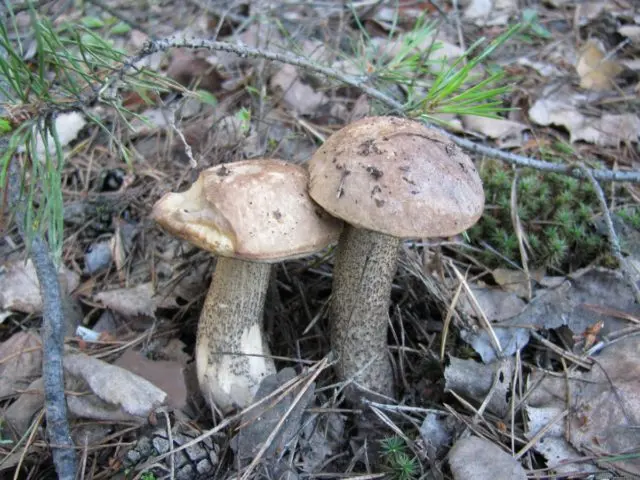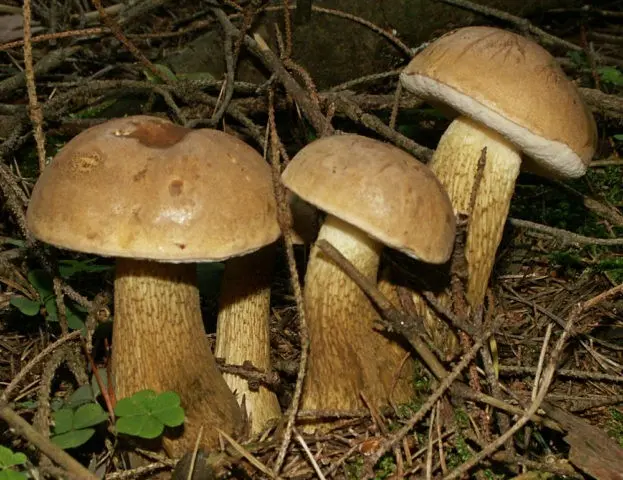Contents
The boletus is pinking, variegated or oxidizing, the birch is multi-colored – this is the name of the same mushroom of the Boletaceae family. This species is a close relative of the boletus and is characterized by high taste, therefore it is suitable for any type of processing without prior preparation. The official name is Leccinum roseafractum.
Where does the pinking boletus mushroom grow
This mushroom prefers to grow in the tundra and humid forests of the Northern regions. And also it can be found in the highlands, in combination with tree and shrub birches. It can not always be found at the base of trees, often it is located away from the trunk above young roots.
The fungus grows separately in small groups of 2-3 pieces in a birch or mixed forest. Prefers to camouflage in thickets of tall grass and moss. Often it can be found on the shores of forest lakes, swamps, and also near peat bogs.
The pinking boletus is widespread in the northern part of Western Europe. But you can meet him only during a period of high humidity in the forest.
What does a pinking boletus look like
This species has a classic form of the structure of the fruiting body. Therefore, his hat and leg are clearly expressed. The upper part is characterized by a small size, and its diameter in adult specimens does not exceed 7 cm. The height of the fruiting body is 12-15 cm, but there are some exceptions that reach 20 cm.

The size of the pinking boletus is much smaller than its relatives
At the initial stage of growth, the cap is hemispherical, smooth, but as it matures, it becomes convex, cushion-shaped. The surface is yellow-brown in color, on which randomly arranged light spots are clearly visible, which gives the impression of a marble pattern. This feature is a distinctive feature of the species.
On the reverse side of the cap there is a tubular layer, which initially has a light shade, and as the spore powder matures, it becomes a dirty gray color. When pressed with a finger, it quickly turns pink.
The pulp has a dense texture of white color. But upon contact with air, the boletus initially turns pink on the cut, and then darkens. Because of this feature, the mushroom got its name. In mature specimens, the flesh becomes loose and watery.
The leg of the pinking boletus is cylindrical, slightly thickened at the base. It can be either flat or slightly curved towards the sun’s rays. Its main shade is light, and thick dark gray scales are located on top. In external color, the leg resembles a birch trunk. The flesh of the lower part is initially dense, and as it matures, it becomes fibrous.
Is it possible to eat pinking boletus
This species is considered edible. It is suitable for consumption both fresh and processed.
Only young specimens need to be collected and harvested, since when ripe, the structure of the pulp changes significantly and becomes unsuitable for food.
The taste of the mushroom
In terms of taste, this species belongs to the second category. When broken, the flesh exudes a pleasant mushroom smell. Fresh and cooked, it tastes slightly sweet.
Benefits and harm to the body
The pinking boletus has a rich chemical composition. It contains the following components:
- carbohydrates, proteins, fats, fiber;
- vitamins of group B, C, PP;
- mono-, disaccharides;
- alimentary fiber;
- unsaturated fatty acids;
- minerals (phosphorus, calcium, iron, manganese, potassium, magnesium, sodium).
Thanks to this, the mushroom has many beneficial properties for the human body. Its regular use helps:
- reduce the content of bad cholesterol in the blood;
- normalize pressure;
- accelerate the processes of hematopoiesis;
- improve metabolism;
- improve immunity;
- normalize the functioning of the digestive system.
Pinking boletus can harm the body only with individual intolerance to the product. Therefore, in case of signs of allergy, it is necessary to exclude the fungus from the diet. In the presence of complications of the situation, you should immediately call a doctor.
False doubles
By external signs, the pinking boletus is in many ways similar to the gall fungus, which is considered poisonous. Therefore, you should know the hallmarks of a false double in order to avoid intoxication of the body.
You can recognize the gall fungus by the rough surface of the cap, which is palpable if you run your finger over it. It should also be alert that adult specimens do not have even the slightest signs of worminess. This is due to the fact that insects do not eat the false twin due to bitterness.
Important! The gall fungus grows in oak groves near rotten stumps or ditches, which is unusual for a boletus.

Gall fungus is not wormy even when ripe
The hat of the double does not have a characteristic marble pattern, its shade can be red-green or bright brown. The surface of the leg is covered with a beige mesh resembling blood vessels.
Collection rules
The fruiting period of the pinking boletus begins in June and lasts until the end of October. This species is characterized by rapid growth and, under favorable conditions, grows by 4 cm per day, and after six days it fully matures.
Young specimens should be collected, as in the process of growing up, the taste properties deteriorate, and the pulp becomes watery.
When harvesting, you need to cut the boletus at the base with a sharp knife so as not to damage the mycelium. This will allow collection at the same location each year.
Use
Pinking boletus can be fried, pickled, stewed, boiled. In addition, it can be dried and frozen. The only drawback of the species is that the flesh turns black during heat treatment.
The structure of the boletus stem is a little tougher, so it needs a longer heat treatment. The lower part is best used for cooking soups, sauces, main courses, combining it with vegetables and meat. Hats are best used for baking, frying, drying, pickling, and can also be used fresh.
Conclusion
The pinking boletus is a delicious mushroom that enjoys well-deserved popularity among lovers of quiet hunting. You can meet him in the forest only at high humidity, since during dry periods the development of the mycelium stops. But when collecting, it is necessary to clearly know the characteristic differences of the species, so as not to confuse it with a false double.









